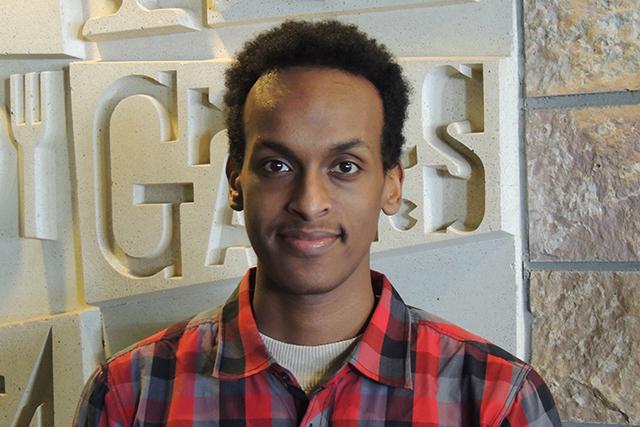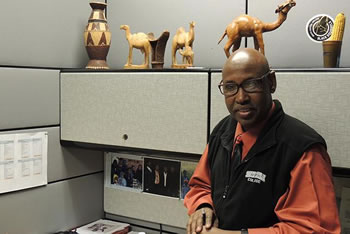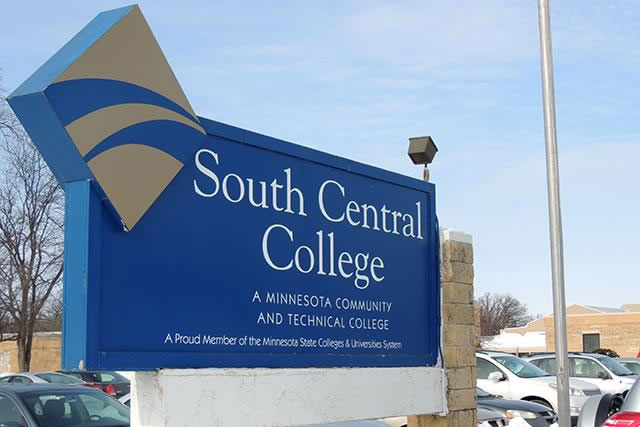For rural immigrants with college dreams, higher ed often begins close to home

MinnPost photo by Gregg Aamot
Mustafa Omar hopes to earn an associate degree at South Central College before transferring to a four-year school.

By Gregg Aamot
Tuesday, April 08, 2014
NORTH MANKATO, Minn. — Mustafa Omar graduated from St. Peter High School last spring with a clear goal in mind — earning a degree in petroleum engineering — but only a vague idea about how to achieve it.
Minnesota State University in nearby Mankato, with its sprawling campus of 18,000 students, felt a bit too big. As for Gustavus Adolphus College, the private school in his hometown with the $40,000 tuition, he said: “I didn’t even think about it.”
That left a third option close to home: South Central College, a community and technical college about a dozen miles away. But even that posed a problem.
“I needed a car,” he said.
Over the summer and fall, Omar worked at a packaging plant in St. Peter, earning enough money to buy the 2009 Chevy Impala that now gets him to classes at South Central, where he hopes to earn an associate degree before transferring to a four-year school.
“I have only been here a month, but I like it,” he said one recent morning on the college’s campus here. “I like the class sizes. I like the teachers.”
Though Omar grew up in Syria (his family has roots in Somalia), he said he always wanted to live in the United States.
“One of the main reasons we are here is to get a good education,” he said of his family. “That is our goal.”
Where to start?
For years, many of the state’s newest immigrants and refugees have been building lives in small Minnesota towns — places like Willmar or Worthington or St. James, where they were first lured by the prospect of jobs in meatpacking plants or other agricultural industries.
Now many of them, eager to push beyond those boundaries, are getting a start in higher education at the array of public colleges and universities planted around the state, especially two-year community and technical colleges. They are taking advantage of what two-year colleges have long offered — lower tuition, smaller class sizes and a close proximity to home — as well as a layer of developmental courses in English, some tailored to those for whom English is a second, or third or fourth, language.
Indeed, over a five-year period ending in 2013, the enrollment of Latino students in the Minnesota State Colleges and Universities (MnSCU) system — the state’s largest higher-education system with seven universities and 24 two-year colleges — increased 35 percent while the enrollment of black or African-American students jumped 41 percent, according to statistics provided by MnSCU. About 37,000 students in those two groups are enrolled in MnSCU schools.
While it is unclear how many of these students are from newer immigrant or refugee communities — Hispanic, Somali, Sudanese and others — anecdotal evidence and interviews with teachers and college administrators suggest that more and more newcomers are gaining a foothold in higher education at the small schools in their midst.

MinnPost photo by Gregg Aamot
Fanah Adam is responsible for recruiting potential students in seven Minnesota high schools in this region of southern Minnesota: Mankato East, Owatonna, Lake Crystal, Madelia, St. James, Faribault and Le Sueur. |
At South Central, Fanah Adam, a student adviser, said the number of students he refers to as “new Americans” — roughly speaking, recent immigrants or refugees or their children, many of them Somali — jumped from less than 20 when he arrived, in December 2009, to about 145 this semester on the college’s campuses in North Mankato and Faribault.
Adam is responsible for recruiting potential students in seven Minnesota high schools in this region of southern Minnesota: Mankato East, Owatonna, Lake Crystal, Madelia, St. James, Faribault and Le Sueur. He visits the schools, speaks at community centers and posts fliers around the towns, emphasizing South Central’s size and cost and, importantly, its English preparatory courses.
Of the “new Americans” he meets on these rounds, he said: “I basically tell them, 'it’s better for you to start here.' "
Adam was born in Somalia but fled in 1988, three years before the outbreak of civil war there, and spent 16 years teaching in Yemen before coming to Minnesota. A shelf in his office holds the artifacts of home: carved wooden camels, a milk container, a wooden camel herder’s headrest. A camel bell known as a koor hangs on the wall.
Adam keeps track of the students he recruits, reaching out to them through phone calls, email messages and hallway interactions.
“If they can make it for one year, they will be OK. They will finish,” he said.
Forging connections
Minnesota’s changing demographics are evident at several small colleges across the state.
At Ridgewater College (where this reporter teaches), for instance, the number of students identified as black or African-American on its campuses in Willmar and Hutchinson rose from 86 in 2009 to 181 in 2013, according to the college. For Latino students over that same period, the number increased from 198 to 216. Combined, the two groups make up about 7 percent of the enrollment.
Last fall, about 250 Latino students showed up for a college fair at Riverland Community College’s campus in Owatonna (the school also has campuses in Austin and Albert Lea). Miguel Garate, the school’s international student adviser, often visits churches in the region on the weekends — and drops in on the occasional family picnic — in the hopes of forging some connections with parents.
Garate emphasizes three Riverland offerings when he talks to prospective students: courses for English learners known as English for Academic Purposes; a summer program called Be Your Best that offers free courses in basic reading, writing and math; and relationships with local businesses that connect students with jobs after they graduate. About 8 percent of the school’s student body consists of Latino students.
“We want them to come here for school, but we also want them to stay here after they are done,” Garate said. “I tell them, ‘use Riverland to get your education, then stay in our community.’ ”
Even the Iron Range, where recent immigration has been modest, offers an interesting tangent; of the 64 students who entered the nursing program at Hibbing Community College last fall, about a dozen were from African immigrant communities, according to Barb Bozicevich, the director of the nursing program. (Most of them are Twin Cities residents who live on the Range during the week.)
‘An explosion’ of diversity
Here in North Mankato, a town of 13,000 on the banks of the Minnesota River, the trend is striking.
South Central instructor Amy Magnus said the past two years have brought “an explosion” of Somali and, to a lesser extent, Sudanese students to the North Mankato campus — an observation supported by the makeup of students walking the halls. She added, with a laugh: “I teach American Racial Minorities, and it’s getting to the point where I might just hand (the Somali students) the Somali unit and give them the floor.”
During a recent visit to the school, flat screens high on the wall in the cafeteria and around campus promoted an array of cultural activities, including an upcoming Hispanic student conference. Students played pool in the student lounge, below a huge American flag bordered by more than two dozen smaller flags of other countries.
Ameera Alhamidi was one of seven students working on their English in a class called English for Academic Purposes: Reading and Oral Communication. Like all of the other women sitting in the classroom, she wore the traditional Muslim head scarf, revealing an oval of her face.
'It's just easier to start here'
Asked why she was attending South Central, Alhamidi, a refugee from Iraq who has lived in the United States for about three years, said a friend recommended the school — in part because of the help Alhamidi could get with English.
She added: “It’s just easier to start here. It’s not like (Minnesota State), where it is so big. I would be lost there.”
Around lunchtime, Omar, the St. Peter graduate, found a sitting area just off of a hallway and sat down, studying alone. He took off the gray headband that he had worn during his early classes, finally warming up on a morning when the temperature hovered around zero.
Omar has his sights set on the University of Texas, a logical place, of course, to pursue studies in petroleum. On this day, though, he was happy to be getting a start on the frozen Minnesota prairie.
“With all of this cold, I was worried that my car wouldn’t start and I would be missing classes,” he said. “But it’s been no problem — so far.”
